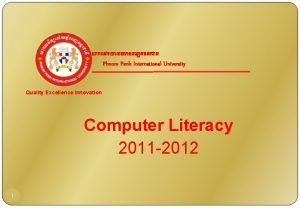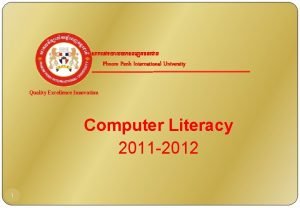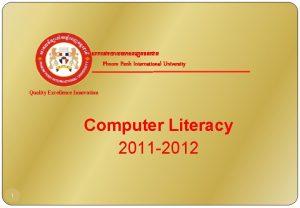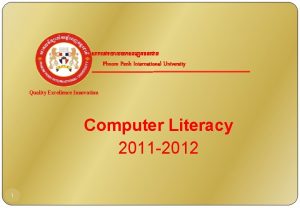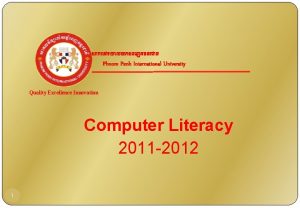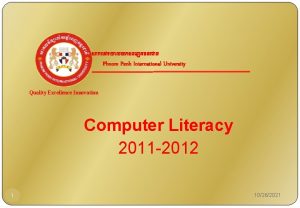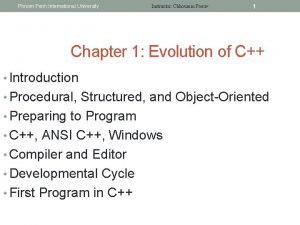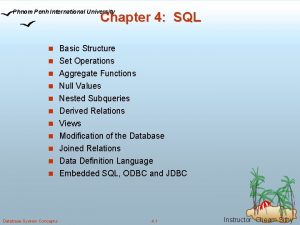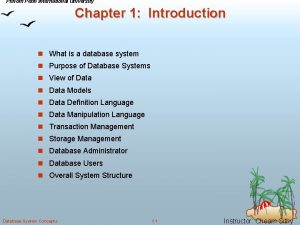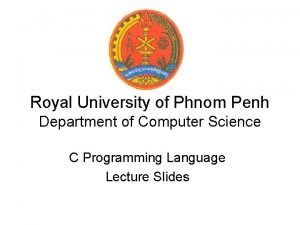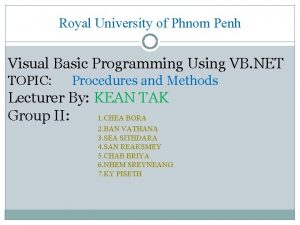Phnom Penh International University Quality Excellence Innovation Computer
























- Slides: 24

ស កលវទយ លយភនព ញអនតរជ ត Phnom Penh International University Quality Excellence Innovation Computer Literacy 2011 -2012 1

Chapter 5 The Processor Unit 2

Objectives 3 After this chapter, students would be able to understand: • What is Processor Unit • History of Processor • How does CPU work with other Devices • Kind of CPU

What is Processor? • The Processor can be called Central Processing Unit (CPU). • CPU interprets and carries out the basic instructions that operate a computer. • The CPU plays a role somewhat analogous to the brain in the computer. • There are 2 typical components of a CPU: Ø The Arithmetic Logic Unit (ALU), which performs arithmetic and logical operations Ø The Control Unit (CU) is the component of the processor that directs and coordinates most of the operations in the computer, which extracts instructions from memory and decodes and executes them, calling on the ALU when 4 necessary.

The CPU Speed • Inside a processor has 2 main functions: Ø The registers, that temporarily hold data and instructions Ø The system clock controls the timing of all computer operations • The pace of the system clock is called the clock speed, and is measured in gigahertz (GHz). The higher clock speed, the faster of processing data. • CPU registers are: Ø Very fast (access times of a few nanoseconds) Ø Low capacity (usually less than 200 bytes) Ø Very limited expansion capabilities Ø Expensive (more than one dollar/byte) 5

How CPU Work? Parallel processing uses multiple processors simultaneously to execute a single program or task Massively parallel processing involves hundreds or thousands of processors 6

How CPU Work with Other Devices? • For every instruction, a processor repeats a set of four basic operations, which comprise a machine cycle 7

How CPU Work with Other Devices? (cont. ) 8

How CPU Work with Other Devices? (cont. ) • Most current personal computers support pipelining. Each time the CPU executes an instruction, it takes a series of steps. • The complete series of steps is called a machine cycle. A machine cycle can be divided into two smaller cycles. 9

How CPU Work with Other Devices? (cont. ) • These are instruction cycle and execution cycle: – Instruction cycle: In instruction cycle CPU takes 2 steps: 1)Fetching: Before the CPU can execute an instruction, the control unit must retrieve or fetch a command or data from the computer's memory and the Processor begins fetching a second instruction before it completes the machine cycle for the first instruction. 2)Decoding: Before a command can be executed, the control unit must decode the command into instruction set. 10

How CPU Work with Other Devices? (cont. ) –Execution cycle: In execution cycle CPU also takes 2 steps: 1)Executing: When the command is executed, the CPU carried out the instructions in order by converting them into macrocode. 2)Storing: The CPU may be required to store the result of an instruction in memory. 11

How CPU Work with Other Devices? (cont. ) 12

Kind of CPUs • The leading manufacturers of • personal computer processor chips are Intel and AMD CPU is using with different devices. Example: 1. CPU for Mobile Devices 2. CPU for Personal Computer 3. CPU for Server Computer Multi-core processor Dual-core processor Quad-core processor 13

Kind of CPUs (cont. ) PIN First CPU 14

Kind of CPUs (cont. ) CPU for Personal Computer For Server 15

CPU Slot/Socket 16

How to Install CPU 17

How to Install CPU (cont. ) 18

Cooling CPU • A processor chip generates heat that could cause the chip to burn up • Require additional cooling 1. Heat sinks 2. Liquid cooling technology 19

History of AMD CPU Processor Year Bus width 29000 1988 32 32 -bit embedded RISC microprocessor 29050 K 5 1990 1996 32 32 32 -bit embedded RISC microprocessor with integrated FPU Pentium-class processor K 6 1997 32 Pentium/Pentium II-class processor K 6 -2 1998 32 Pentium II-class processor, enhanced version of K 6 -III 1999 32 Pentium II-class processor, enhanced version of K 6 -2 K 7 1999 32 Pentium III/IV class processor K 8 2003 64 Eighth generation of x 86 processors K 10 2007 64 Ninth generation of x 86 processors 20 Description

History of Intel CPU Processor 4004 4040 8008 8080 8085 8086 8088 21 Year Bus width 1971 4 1972 8 1974 8 1976 8 1978 16 1979 8/16 80186 1982 16 80188 1982 8/16 80286 1982 16 Description First microprocessor. Enhanced version of the Intel 4004 processor. First 8 -bit microprocessor. Successor to Intel 8008 CPU. Enhanced version of Intel 8080 CPU. First generation of Intel 80 x 86 processors. 8 bit (external) version of Intel 8086 CPU. Next generation of 80 x 86 processors. Used mostly as embedded processor. Second generation of 80 x 86 processors: new instructions, protected mode, support for 16 MB of memory.

History of Intel CPU (cont. ) Processor Year Bus width 80376 1989 32 80386 1985 32 80486 1989 32 Pentium 1993 32 Pentium II 1997 32 Celeron 1998 32 22 Description Embedded 32 -bit microprocessor based on Intel 80386. Third generation of 80 x 86 processors: 32 bit architecture, new processor modes. Fourth generation of 80 x 86 processors: integrated FPU, internal clock multiplier. Fifth generation of x 86 processors: superscalar architecture, MMX. Sixth generation of x 86 processors. Low-cost version of Pentium II, Pentium III and Pentium 4 processors.

History of Intel CPU (cont. ) Processor Year Pentium III 1999 Pentium 4 2000 Pentium M 2003 Celeron D 2004 Celeron M 2004 Pentium D 2005 Pentium Extreme 2005 Edition Xeon 2006 23 Bus width Description 32 Enhanced and faster version of Pentium II. 32, 64 New generation of Pentium processors. Pentium microprocessor specifically designed for 32 mobile applications 32, 64 Low-cost version Pentium 4 desktop processors. Low-cost microprocessor specifically designed for 32 mobile applications 64 Dual-core CPUs based on Pentium 4 architecture. 64 32, 64 Dual-core CPUs based on Pentium 4 architecture. High-performance version of Pentium 4 CPU.

History of Intel CPU (cont. ) Processor Year Bus width 80860 1989 32 Itanium Core Solo Core Duo Core 2 Pentium Dual. Core Celeron Dual. Core Atom Core i 7 Core i 5 Core i 3 2001 2006 64 32 32 64 Description Embedded 32 -bit microprocessor with integrated 3 D graphics. High-performance 64 -bit microprocessor. 32 -bit single-core microprocessor. 32 -bit dual-core microprocessor. 64 -bit microprocessor. 2007 64 64 -bit low-cost microprocessor. 2008 2009 2010 32, 64 Ultra-low power microprocessor. 64 -bit microprocessor. 24
 Phnom penh
Phnom penh War photographer annotated
War photographer annotated Phnom penh hookers
Phnom penh hookers Rany gilpatrick
Rany gilpatrick Innovation for the sake of innovation
Innovation for the sake of innovation Radical vs disruptive innovation
Radical vs disruptive innovation Quality management for organizational excellence
Quality management for organizational excellence Quality management for organizational excellence
Quality management for organizational excellence Quality and innovation in product and process design
Quality and innovation in product and process design Focus quality innovation
Focus quality innovation Entrepreneurship and innovation bangalore university
Entrepreneurship and innovation bangalore university Quality control and quality assurance
Quality control and quality assurance Pmp quality vs grade
Pmp quality vs grade Pmbok quality assurance vs quality control
Pmbok quality assurance vs quality control Quality improvement vs quality assurance
Quality improvement vs quality assurance Quality improvement vs quality assurance
Quality improvement vs quality assurance Concepts of quality control
Concepts of quality control Quality gurus
Quality gurus Crosby's fourteen steps to quality improvement
Crosby's fourteen steps to quality improvement Old quality vs new quality
Old quality vs new quality Data quality standards iso
Data quality standards iso International aerospace quality group
International aerospace quality group International network for quality assurance agencies
International network for quality assurance agencies International aerospace quality group
International aerospace quality group International aerospace quality group
International aerospace quality group

























